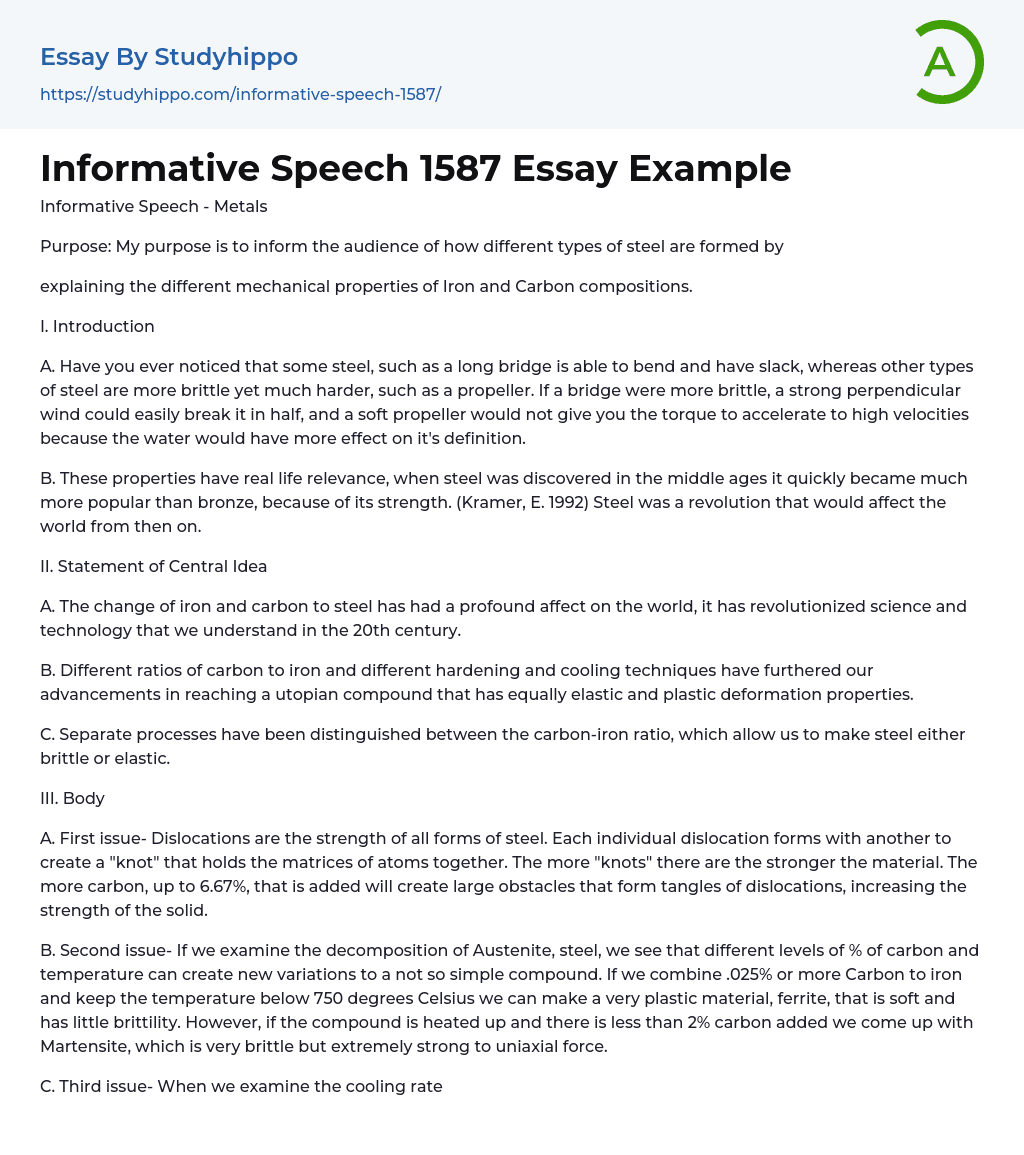Information speech regarding metals.
Purpose: The purpose of this text is to provide information about the formation of different types of steel.
Explaining the various mechanical properties of compositions containing Iron and Carbon.
I. Introduction
Steel can vary in its properties. For example, a long bridge is flexible and can have some slack, while a propeller made of steel is harder yet more brittle. If a bridge were to be brittle, it would easily break in half under strong perpendicular winds. On the other hand, a soft propeller would not provide enough torque to accelerate to high speeds as the water would have a greater impact on its performance.
B. Steel, which was discovered during the middle ages, gained popularity surpassing bronze because of its strength (Kramer, E. 1992). This revolutionary material has had a lasting impact on the world.
II. Central I
...dea Statement
The transformation of iron and carbon into steel has had a significant impact on the world, revolutionizing the science and technology we comprehend in the 20th century.
B. We have made progress in achieving a utopian compound that has both elastic and plastic deformation properties. This progress has been made through the use of various ratios of carbon to iron as well as different hardening and cooling techniques.
Two distinct processes have been identified to determine the carbon-iron ratio, which can lead to the steel being either brittle or elastic.
III. Body
Firstly, dislocations play a crucial role in the strength of all types of steel. These dislocations combine with each other to form "knots" that bind the atomic matrices together. The greater the number of these "knots," the greater the material's strength. Additionally, by increasing the carbon content
up to 6.67%, larger obstacles are created, resulting in a tangle of dislocations and further enhancing the solidity's strength.
The second issue to consider is the decomposition of Austenite, specifically in steel. This involves the varying levels of carbon content and temperature, which can result in the creation of different variations of this complex compound. By adding 0.025% or higher carbon to iron and maintaining a temperature below 750 degrees Celsius, it is possible to produce a malleable material called ferrite. Ferrite is characterized by its softness and low brittleness. On the other hand, if the compound is heated and contains less than 2% carbon, it transforms into Martensite. Martensite is highly brittle but possesses exceptional strength against uniaxial force.
When studying the cooling rates of carbon and iron and the time it takes for them to reach a specific temperature, we observe distinct properties in the resulting solids. Martensite (letter A) undergoes rapid cooling and exhibits highly isothermal transformation. On the other hand, both letter B and C progress through the Ferrite stages, marked by hyperbolas surrounding the regions Ae1 and Ms. These stages involve a less isothermal transformation and result in increased elasticity.
IV. Conclusion
A. The properties of various forms of steel, ranging from iron to temperature, have been examined and their impact on the world has been significant. We have learned how different factors influence the characteristics of steel through this study. Currently, we are witnessing the emergence of newer steel compounds that are both lighter and more durable while maintaining flexibility.
There are two ways to approach steel: one is to passively appreciate the outcomes of others' work, while the other is to actively engage
in it and contribute to engineers' research. If you have no interest in research, your choices are limited. However, if you have any curiosity, take the initiative and create new compounds!
- Organic Chemistry essays
- Acid essays
- Calcium essays
- Chemical Bond essays
- Chemical Reaction essays
- Chromatography essays
- Ethanol essays
- Hydrogen essays
- Periodic Table essays
- Titration essays
- Chemical reactions essays
- Osmosis essays
- Carbohydrate essays
- Carbon essays
- Ph essays
- Diffusion essays
- Copper essays
- Salt essays
- Concentration essays
- Sodium essays
- Distillation essays
- Amylase essays
- Magnesium essays
- Acid Rain essays
- Agriculture essays
- Albert einstein essays
- Animals essays
- Archaeology essays
- Bear essays
- Biology essays
- Birds essays
- Butterfly essays
- Cat essays
- Charles Darwin essays
- Chemistry essays
- Dinosaur essays
- Discovery essays
- Dolphin essays
- Elephant essays
- Eli Whitney essays
- Environmental Science essays
- Evolution essays
- Fish essays
- Genetics essays
- Horse essays
- Human Evolution essays
- Isaac Newton essays
- Journal essays
- Linguistics essays
- Lion essays




